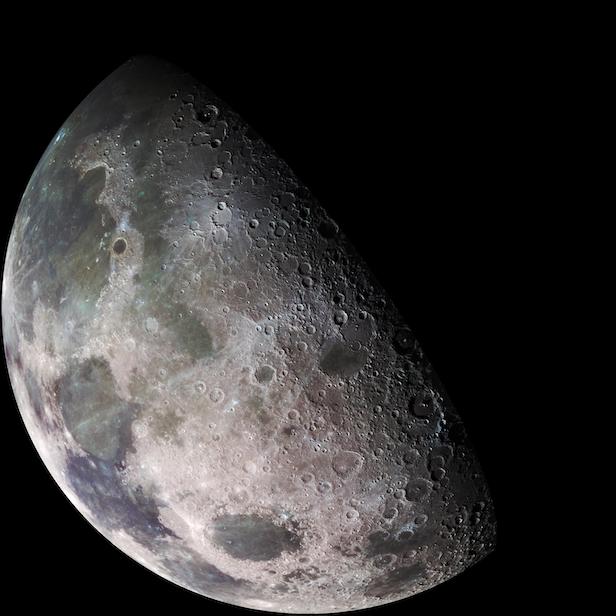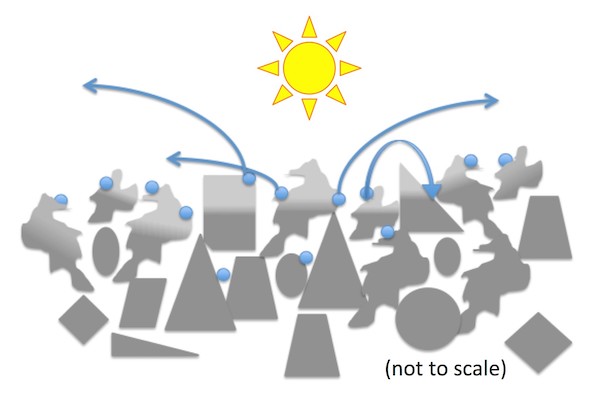Water on the Moon shifts around during the day
The change in surface temperature throughout the dayside on the lunar surface can cause water on the surface to move location

Data from the SwRI-led LAMP instrument aboard NASA’s Lunar Reconnaissance Orbiter indicate that water molecules scattered on the surface of the Moon are more common at higher latitudes and tend to hop around as the surface heats up. Image credit: NASA/JPL/USGS
Using the Southwest Research Institute-led Lyman Alpha Mapping Project (LAMP) aboard NASA’s Lunar Reconnaissance Orbiter (LRO), scientists have observed water molecules moving around the dayside of the Moon. A paper recently published in Geophysical Research Letters describes how LAMP measurements of the sparse layer of molecules temporarily stuck to the surface helped characterise lunar hydration changes over the course of a day.
Up until the last decade or so, scientists thought the Moon was arid, with any water existing mainly as pockets of ice in permanently shaded craters near the poles. More recently, scientists have identified surface water in sparse populations of molecules bound to the lunar soil, or regolith. The amount and locations vary based on the time of day. This water is more common at higher latitudes and tends to hop around as the surface heats up.
“This is an important new result about lunar water, a hot topic as our nation’s space program returns to a focus on lunar exploration,” says SwRI’s Dr. Kurt Retherford, the principal investigator of the LRO LAMP instrument. “We recently converted the LAMP’s light collection mode to measure reflected signals on the lunar dayside with more precision, allowing us to track more accurately where the water is and how much is present.”
Water molecules remain tightly bound to the regolith until surface temperatures peak near lunar noon. Then, molecules thermally desorb and can bounce to a nearby location that is cold enough for the molecule to stick or populate the Moon’s extremely tenuous atmosphere, or “exosphere”, until temperatures drop and the molecules return to the surface. SwRI’s Dr. Michael Poston, now a research scientist on the LAMP team, had previously conducted extensive experiments with water and lunar samples collected by the Apollo missions. This research revealed the amount of energy needed to remove water molecules from lunar materials, helping scientists understand how water is bound to surface materials.

Water molecules are scattered on the lunar surface. As rough, irregularly shaped grains heat up over the course of a day, the molecules detach from the regolith and hop across the surface until they find another location cold enough to stick. Image credit: PSI/Amanda Hendrix
“Lunar hydration is tricky to measure from orbit, due to the complex way that light reflects off of the lunar surface,” Poston says. “Previous research reported quantities of hopping water molecules that were too large to explain with known physical processes. I’m excited about these latest results because the amount of water interpreted here is consistent with what lab measurements indicate is possible. More work is needed to fully account for the complexities of the lunar surface, but the present results show that work is definitely worth doing!”
Scientists have hypothesised that hydrogen ions in the solar wind may be the source of most of the Moon’s surface water. With that in mind, when the Moon passes behind the Earth and is shielded from the solar wind, the “water spigot” should essentially turn off. However, the water observed by LAMP does not decrease when the Moon is shielded by the Earth and the region influenced by its magnetic field, suggesting water builds up over time, rather than “raining” down directly from the solar wind.
“These results aid in understanding the lunar water cycle and will ultimately help us learn about accessibility of water that can be used by humans in future missions to the Moon,” says Amanda Hendrix, a senior scientist at the Planetary Science Institute and lead author of the paper. “A source of water on the Moon could help make future crewed missions more sustainable and affordable. Lunar water can potentially be used by humans to make fuel or to use for radiation shielding or thermal management; if these materials do not need to be launched from Earth, that makes these future missions more affordable.”
Keep up to date with the latest news in All About Space – available every month for just £4.99. Alternatively you can subscribe here for a fraction of the price!




